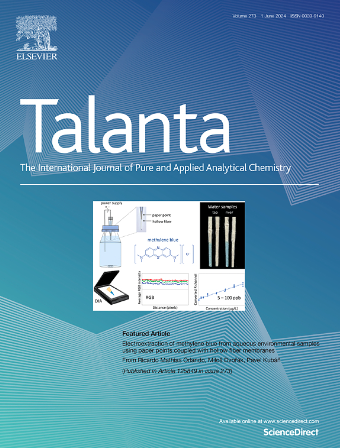Development of an indirect competitive enzyme immunoassay for detection of a plant elicitor methiadinil
IF 5.6
1区 化学
Q1 CHEMISTRY, ANALYTICAL
引用次数: 0
Abstract
Plant elicitors with distinctive benefits including low toxicity, small application dosages and an innovative mode of action are considered as green agrochemicals by stimulating the host plant immunity. Several new plant elicitors have been developed for tobacco protection against virus attack. Among them, as a milestone in Chinese plant elicitor development, methiadinil (IUPAC: 4-methyl-N-(5-methylthiazol-2-yl)-1,2,3-thiadiazole-5-carboxamide) shows broad application prospects. Because of its low application dosage, its residue determination requires diverse highly sensitive method. Here we developed an indirect enzyme-linked immunosorbent assay (ELISA) method for methiadinil residue determination with the lowest detection limit of 10.69 ng/mL and a linear detection range between 21.84 ng/mL of IC20 and 1513.81 ng/mL of IC80 by a rational hapten designation. Meanwhile, this indirect ELISA method showed good specificity with low cross-reactivity for methiadinil analogue determination and a good correlation with the HPLC method for tobacco sample measurement. This sensitive, rapid and accurate methiadinil residue determination method in tobacco leaves is of great significance for the monitoring of methiadinil in tobacco and guidance for other environmental sample determination and the rational application of methiadinil.

建立一种间接竞争性酶免疫分析法检测植物激发子甲巯咪啶
植物激发剂具有低毒性、小剂量和创新的作用方式等独特的优点,通过刺激寄主植物的免疫被认为是绿色农用化学品。几种新的植物激发子已被开发出来,以保护烟草免受病毒的侵害。其中,甲巯咪唑(IUPAC: 4-甲基- n -(5-甲基噻唑-2-基)-1,2,3-噻二唑-5-羧酰胺)作为我国植物激发剂发展的里程碑,具有广阔的应用前景。由于其施用用量小,其残留测定需要多种高灵敏度的方法。本文建立了甲巯咪啶残留间接酶联免疫吸附测定法(ELISA),最低检出限为10.69 ng/mL, IC20和IC80的线性检出范围在21.84 ng/mL和1513.81 ng/mL之间。同时,间接ELISA法测定甲巯脒类似物特异性好,交叉反应性低,与高效液相色谱法测定烟草样品具有良好的相关性。这种灵敏、快速、准确的烟叶中甲巯咪啶残留测定方法,对烟叶中甲巯咪啶的监测和其他环境样品的测定及甲巯咪啶的合理应用具有重要的指导意义。
本文章由计算机程序翻译,如有差异,请以英文原文为准。
求助全文
约1分钟内获得全文
求助全文
来源期刊

Talanta
化学-分析化学
CiteScore
12.30
自引率
4.90%
发文量
861
审稿时长
29 days
期刊介绍:
Talanta provides a forum for the publication of original research papers, short communications, and critical reviews in all branches of pure and applied analytical chemistry. Papers are evaluated based on established guidelines, including the fundamental nature of the study, scientific novelty, substantial improvement or advantage over existing technology or methods, and demonstrated analytical applicability. Original research papers on fundamental studies, and on novel sensor and instrumentation developments, are encouraged. Novel or improved applications in areas such as clinical and biological chemistry, environmental analysis, geochemistry, materials science and engineering, and analytical platforms for omics development are welcome.
Analytical performance of methods should be determined, including interference and matrix effects, and methods should be validated by comparison with a standard method, or analysis of a certified reference material. Simple spiking recoveries may not be sufficient. The developed method should especially comprise information on selectivity, sensitivity, detection limits, accuracy, and reliability. However, applying official validation or robustness studies to a routine method or technique does not necessarily constitute novelty. Proper statistical treatment of the data should be provided. Relevant literature should be cited, including related publications by the authors, and authors should discuss how their proposed methodology compares with previously reported methods.
 求助内容:
求助内容: 应助结果提醒方式:
应助结果提醒方式:


